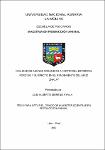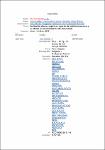Mostrar el registro sencillo del ítem
Calidad de abonos orgánicos a partir del estiércol porcino y su efecto en el rendimiento del Maíz Chala
| dc.contributor.advisor | Cadillo Castro, José | |
| dc.contributor.advisor | Chura Chuquija, Julián | |
| dc.contributor.author | Moreno Ayala, Luis Alberto | |
| dc.date.accessioned | 2019-05-22T19:20:02Z | |
| dc.date.available | 2019-05-22T19:20:02Z | |
| dc.date.issued | 2019 | |
| dc.identifier.uri | https://hdl.handle.net/20.500.12996/3942 | |
| dc.description | Universidad Nacional Agraria La Molina. Escuela de Posgrado. Maestría en Producción Animal | es_PE |
| dc.description.abstract | Se determino la calidad de los abonos orgánicos a partir del estiércol porcino con el objetivo de evaluar el rendimiento forrajero, valor nutricional de la planta, propiedades fisicoquímicas del suelo post cosecha y utilidad neta. Los abonos orgánicos (biol y biosol) se obtuvieron mediante una fermentación homoláctica y el estiércol sólido a través de un proceso físico. La evaluación se realizó en la empresa Inversiones Analau, ubicada en el distrito de Lurín - Lima. Los tratamientos fueron: fertilizante químico (T1. Control), estiércol sólido (T2), fertilizante químico + estiércol sólido (T3), biosol (T4) y biol (T5). Para el análisis estadístico del rendimiento forrajero se utilizó el diseño de bloques completamente al azar. El valor nutricional de la planta, y las propiedades físicas y químicas del suelo se obtuvieron a través de un análisis de laboratorio. Los resultados para el rendimiento forrajero fueron estadísticamente no significativo (p>0.05); altura de planta (2.62, 2.75, 2.70, 2.76 y 2.55 m), peso mazorca (0.243, 0.264, 0.270, 0.266 y 0.230 kg); peso planta (1.01, 1.08, 1.05, 1.07 y 0.95 kg) y peso por hectárea (68.7, 73.9, 71.5, 73.1 y 64.5 t) respectivamente. El T3 obtuvo mayor proteína cruda 10.5 por ciento, extracto etéreo 1.6 por ciento, fibra cruda 25.4 por ciento y fibra detergente neutra 54.8 por ciento. Sin embargo, mayor energía neta de lactancia (ENl) se obtuvo con el T1, 1.41 Mcal/Kg. Mejores propiedades físicas y químicas del suelo post cosecha se logró con el T2, 2.56 por ciento de materia orgánica, 59.4 ppm fosforo, 230 ppm potasio y clase textural (franco). Mayor rentabilidad económica se obtuvo con el T2, S/. 4270.40 de utilidad neta por hectárea. | es_PE |
| dc.description.abstract | The quality of organic fertilizers was determined from swine manure with the objective of evaluating the forage yield, plant nutritional value, physicochemical properties of the post-harvest soil and net profit. The organic fertilizers (biol and biosol) were obtained by homolactate fermentation and the solid manure through a physical process. The evaluation was carried out at Inversiones Analau, located in the district of Lurin - Lima. The treatments were: chemical fertilizer (T1 Control), solid manure (T2), chemical fertilizer + solid manure (T3), biosol (T4) and biol (T5). For the statistical analysis of forage yield, the completely randomized block design was used. The nutritional value of the plant, and soil physical and chemical properties were obtained through laboratory analysis. The results for forage yield were statistically not significant (p> 0.05); plant height (2.62, 2.75, 2.70, 2.76 and 2.55 m), weight of maize (0.243, 0.264, 0.270, 0.266 and 0.230 k); plant weight (1.01, 1.08, 1.05, 1.07 and 0.95 k) and weight per hectare (68.7, 73.9, 71.5, 73.1 and 64.5 t) respectively. T3 had the best crude protein 10.5 percent, ethereal extract 1.6 percent, crude fiber 25.4 percent and neutral detergent fiber 54.8 percent. However, higher net energy for milking (EN1) was achieved by T1, 1.41 Mcal/k. Better physical and chemical properties of post-harvest soil was achieved with T2, 2.56 percent organic matter, 59.4 ppm phosphorus, 230 ppm potassium and textural class (loam). Greater economic profitability is obtained with T2, S/. 4270.40 net profit per hectare. | en_US |
| dc.description.uri | Tesis | es_PE |
| dc.format | application/pdf | en_US |
| dc.language.iso | spa | es_PE |
| dc.publisher | Universidad Nacional Agraria La Molina | es_PE |
| dc.rights | info:eu-repo/semantics/openAccess | en_US |
| dc.rights.uri | https://creativecommons.org/licenses/by-nc-nd/4.0/ | * |
| dc.source | Universidad Nacional Agraria La Molina | es_PE |
| dc.source | Repositorio institucional - UNALM | es_PE |
| dc.subject | Zea mays | es_PE |
| dc.subject | Estiércol | es_PE |
| dc.subject | Cerdo | es_PE |
| dc.subject | Abonos orgánicos | es_PE |
| dc.subject | Suelo | es_PE |
| dc.subject | Ph | es_PE |
| dc.subject | Ph del suelo | es_PE |
| dc.subject | Propiedades físico-químicas suelo | es_PE |
| dc.subject | Análisis microbiológico | es_PE |
| dc.subject | Valor nutritivo | es_PE |
| dc.subject | Aplicación de abonos | es_PE |
| dc.subject | Respuesta de la planta | es_PE |
| dc.subject | Rendimiento de la planta | es_PE |
| dc.subject | Costos de producción | es_PE |
| dc.subject | Rentabilidad | es_PE |
| dc.subject | Evaluación | es_PE |
| dc.subject | Perú | es_PE |
| dc.subject | Maíz Chala | es_PE |
| dc.subject | Estiércol porcino | es_PE |
| dc.subject | Biol | es_PE |
| dc.title | Calidad de abonos orgánicos a partir del estiércol porcino y su efecto en el rendimiento del Maíz Chala | es_PE |
| dc.type | info:eu-repo/semantics/masterThesis | en_US |
| thesis.degree.discipline | Producción Animal | es_PE |
| thesis.degree.grantor | Universidad Nacional Agraria La Molina. Escuela de Posgrado | es_PE |
| thesis.degree.name | Magister Scientiae - Producción Animal | es_PE |
| thesis.degree.level | Maestría | es_PE |
| dc.subject.ocde | https://purl.org/pe-repo/ocde/ford#4.01.01 | es_PE |
Ficheros en el ítem
Este ítem aparece en la(s) siguiente(s) colección(ones)
-
M-PAN Tesis [96]




